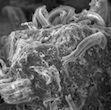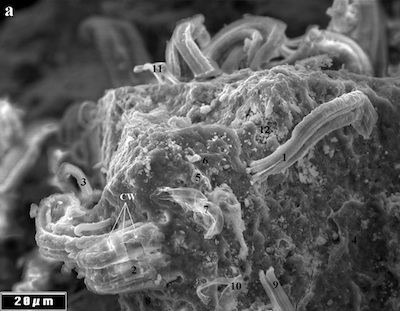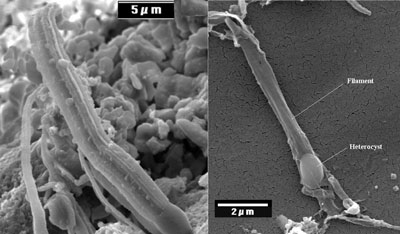 Have we made “first contact” with fossilized alien microbes? A recent study by astrobiologist Richard B. Hoover of NASA’s Marshall Space Flight Center says “yes”. Pretty much everyone else says, “no,” or at the very least, “I’m skeptical.” If the claim is indeed verified, it will be a turning point in human history; If not, just another item in the list of unresolved questions surrounding the search for life beyond Earth.
Have we made “first contact” with fossilized alien microbes? A recent study by astrobiologist Richard B. Hoover of NASA’s Marshall Space Flight Center says “yes”. Pretty much everyone else says, “no,” or at the very least, “I’m skeptical.” If the claim is indeed verified, it will be a turning point in human history; If not, just another item in the list of unresolved questions surrounding the search for life beyond Earth.
Study claims Ivuna & Orgueil meteorites contain fossilized alien microbes
In a paper published in this month’s edition of Journal of Cosmology, author and highly respected NASA scientist Richard B. Hoover concludes that observations of the chemistry and morphology of microscopic filamentous structures embedded in type CI1 carbonaceous meteorites Ivuna and Orgueil indicate the presence of fossilized, extra-terrestrial bacteria. The paper makes various mentions of chemical markers that may or may not be indicative of a biological origin for these micro-worms, but Hoover’s main line of evidence surrounds comparisons between the shape and size of the alleged ETs and their would-be earthling counterparts.

Picture showing could-be ET fossils

Comparison of structures seen in the meteorites (left) and a living terrestrial bacteria (right)
This sounds oddly familiar…
This is not the first time claims have been made of the finding of fossilized bacteria in meteorites. Far from it. You may recall the famous Allan Hills ALH-84001 meteorite debate in 1996. The meteorite was found in Antarctica on in 1984 by a team of U.S. meteorite hunters from the ANSMET project. Thought to be from Mars, ALH-84001 also had little squiggly things in it that resembled known terrestrial bacteria. Upon the announcement that these squiggles may have at one time been alive, the expected media frenzy ensued. Soon, after hundreds of other scientists in the field had reviewed the matter, it was generally agreed upon that the "worms" inside ALH-84001 were not bacteria and never were.
This isn’t the first time we’re hearing this very argument from Hoover himself, either. In a 2006 paper published in SPIE, Hoover makes the exact same claims as in his new paper, saying:
"… studies of freshly fractured interior surfaces of the Orgueil meteorite have resulted in the detection of the fossilized remains of a large and diverse population of filamentous prokaryotic microorganisms."
In addition, Hoover has given several talks on this very subject. Why this new study is being picked up by the press when the others were not I cannot say.

Alleged fossilized microbes from ALH-84001
Experts advise skepticism
Because of the intrinsic controversial nature of Hoover’s paper, the Journal of Cosmology has invited 100 experts and has issued a general invitation to over 5,000 scientists from the scientific community to review the paper and to offer their critical analysis. The Journal will publish the expert reviews along side Hoover’s paper this Monday.
Many scientists (experts and non-experts alike) are already commenting on their own blogs and to the press about their thoughts on Hoover’s claim:
"This may turn out to be another one of those cases where it’s controversial but remains unproven."
Shostak said Hoover’s findings would be "important, if true." But he noted that the research paper relied on a highly technical interpretation of electron microscope images and chemical analyses. "Is it true? I’m not qualified to say that."
— Seth Shostak, senior astronomer at the California-based SETI Institute
(as reported by MSNBC)
"Many scientists have examined thousands of meteorites in detail over the past 50 years without finding any evidence of fossil life. Further, we know a great deal about the conditions on the parent objects of the meteorites, which (not counting the few meteorites from the moon and Mars) were rather small, not at all like planets.
I would therefore invoke Carl Sagan’s famous advice that extraordinary claims require extraordinary evidence. At a bare minimum this would require publication in a prestigious peer-refereed scientific journal — which this is not. Cyanobacteria on a small airless world sounds like a joke. Perhaps the publication came out too soon; more appropriate would have been on April 1"
— David Morrison, senior scientist at the NASA Astrobiology Institute at Ames Research Center
(as reported by MSNBC)
"Clearly, Hoover thinks terrestrial contamination is unlikely. However, contamination, no matter how unlikely, is a more mundane explanation than extraterrestrial life, and Occam’s Razor will always shave very closely here. We have to be very, very clear that contamination was impossible before seriously entertaining the idea that these structures are space-borne life.
I’ll be honest: my own reaction is one of extreme skepticism. As it should be! All things being equal, I would take news like this with a very large grain of salt, and want a whole lot of outside expert analysis."
— Phil Plait (aka Bad Astronomer)
(from the Bad Astronomy blog)
The bottom line
Have we found definitive proof of alien life embedded in a meteorite? No. The Journal of Cosmology (a journal known for publishing "pseudo science", which is coincidentally going out of business) has published one error-laden* article by a scientist who has been making this very claim for quite some time now. While it’s fun to believe (and trust me, I’d love to think that we really had found life!) that Hoover’s claims are true, the evidence is already stacking against him. I do not claim to be an expert in this field by any means, but as an objective reader I have to say I’m not convinced. I am anxious to see what the 100 experts called upon by JOC have to say on Monday.
*Not only is the article full of grammatical errors, but it makes scientific justifications that are simply untrue. As Bad Astronomer notes: "Not once, but twice, the article states that WISE data exist which support the idea of a planet in the outer solar system ("…This model coupled with data from WISE, indicates the presence of a gas planet…" for example). That is simply wrong; the actual truth is that no WISE observations analyzed so far show any sign of such a planet."
What would Data Say?
What this debate really needs is some scanning for life forms by a real expert.
This article is also cross-posted at Kayla’s blog on NPR’s Science Friday

Keep watching the skies! :)
Shostak’s comment is the only one that reads as particularly bright. ;-)
*Adopting Kent Brockman voice*
“If true, I for one welcome our new alien microbe overlords.”
Why did you have to make me remember Generations…
yawn who cares about real aliens and real science and stuff
i prefer to live my life thinking only about star trek and a few other Sci Fi movies…my eyes kinda glaze over and my brain shuts down when anyone talks to me about real space stuff
i think you’ll find thats kind of the norm for 95% of trek fans.
its a sad life but hey its just how we roll
@5 Trekkie4eva I beg to differ. I think MOST people who are interested in TRUE science fiction are interested in science as well.
Many people who claim to be “science fiction fans” are really more interested in other things, like: girls in short tight dresses, things that blow up real good, space opera, adolescent sexual fantasies and such.
While much of Star Trek is just action-adventure and soap opera, the thrill of watching TOS for the first time was seeing a view of the future, imagining other worlds and the creatures that could inhabit them.
But I agree let’s leave science to the scientists. As for deciding whether those structures are really organisms or not, why don’t they call in some real experts: the microbiologists and arche-biologists, who can compare those structures to fossilized bacteria on Earth?
What do astrophysicists know about bacteria?
You all missed UFO day on the History Channel yesterday. According to them millions, yes, millions of Americans are probed and abducted by aliens. Forget microbes, we need to be checking for alien STD’s!!
Insert Charlie sheen joke here…..
I still insist that there must be some form of life out there, beyond terrestrial life as we know it here. This might not be substancial enough as evidence, but it’s a sign that these worms might just come from outer pace. http://www.amazon.com/s/ref=nb_sb_noss?url=search-alias%3Ddigital-text&field-keywords=wade+hilton
Its life Jim…..
Jeez! what’s the point of giving them billions of dollars to search for life if they’re just going to debunk every little thing.
@10. Seriously? I can’t tell is there is sarcasm in there. But, if not: you would really want scientists making up stories rather than “debunking” bad science? If that is truly what you want science research funding to go toward, you don’t understand what science is: the pursuit of truth, which works through rigorous peer review and critical analysis.
@6 Well said!
#5 Sci-fi is about imagining what might be. Who might be out there. What might be out there. What’s the point in imagining if you don’t want to find out? Squiggly lines in a rock that may or may not have once been bacteria may not be as eyepoppingly exciting as those wonderful special effects of the giant space ship hovering over a recognizable Earth city. But given the distances and our current level of technology, it’s probably the best any of us can hope for in our life times.
I knew him when he was just plain Mr. Hover. He was a strong supporter of the Viking experiments which seemed to prove that there were organic materials in the Martian surface. The results are widely considered to be due to something other than that, but he persisted. I hope he is right this time. It would be great news.
oh come oneeee, fossilized alien microbes?? microbes?? why is so hard to understand, aliens exists and that’s it. there were so many things that make proof aliens exists, more proofs than God exists.
As a Scanning Electron Microscopist with 24 years of experience working in the specialized field I find claims of evidence of extraterrestrial life based solely on isolated structures in a carbonaceous meteorite highly speculative at best. The article does not make it clear how the supposed chemical markers were identified. Most likely the chemical data was obtained by energy dispersive x-ray spectrometry (EDX) in situ in the SEM. EDX can not distinguish chemical structures or even compounds, but merely elemental ratios within the electron beams interaction volume (which for a carbon sample will be much larger than the SEM electron image resolution). To conclude that C, H, and oxygen detected by EDX in a meteorite was from organic or biological origin is wildly speculative and unfounded.
As for the structure/morphology being similar to that of terrestrial biological organisms, I find the claim ludicrous. As I forthrightly tell those for whom I do my SEM work, “If you look long enough in almost any sample you can find almost any structure that you want to find.” Observing isolated structures that “look similar” to the form of biological organisms proves nothing and is virtually meaningless.
ahaha that clip of Data never gets old. I still haven’t figured out that snappie-clap sound he makes with his hands……I mean, not that I sit there and try…
I am looking out my window right now. Whoa! That cloud looks like a duck! It must be a duck because it looks like a duck! There are giant animals floating in the sky! I’ve prooved it!
I am alien!
I’ve never seen you at the meetings, Daharijs.
Nanoo nanoo!
Even before the 1996 fiasco, reports of finding life in meteorites (usually dormant bacteria, rather than fossils) date back to the 1800s and have always been shown to be quite flimsy when actually subjected to scientific analysis.
@17 I’ve been saying that for years. Where is my one billion government grant.
Not to mention the fools who completely ignor the evidence of the transitionary clouds.
This stuff always drives me crazy. How can they be “Not sure” about these things? They can “be sure” that there’s a planet orbiting a star millions of light-years away. They can “be sure” of what the temperature is on that planet, and “be sure” how close it’s orbiting to that star. They can “be sure” how old fossilized remains are on Earth with carbon-dating. They can “be sure” about the Big Bang. They can “be sure” of what primitive life was like on Earth.
But, they can never “be sure” about something right in front of their face, under an electron microscope????? I just don’t get that.
The quality of this work is highly questionable considering the reputation of the Journal of Cosmology. Also there’s this… in part of his publication he’s making inferences about life on Europa and Enceladus based on the colors of terrestrial microbes and the colors of those moons shown in Galileo and Cassini images… and the images he’s referring to are enhanced, FALSE COLOR images of those moons. Is that great science or what?
@23
I remember the Rock from Mars story from 93 (i think it was 93) and the detail was incredible. 20 million years ago a meteor his mars sending the rock into space where it went into orbit for 4 million years before finally crashing to earth 80,000 years ago.
Ok those figures i just pulled out of my head but i point out they could call all of that in undeniable detail and yet could not get the science right based on what they had.
@23 and 25.
To answer a question like, “how can they be unsure of this?” You have to understand what it means, in science, to “know” something. Everything in science is, to a degree, speculative.
The quality of the science (what makes it “good science” or “bad science”) depends upon the amount of concrete evidence that leads one to a conclusion.
We are not, by any means, SURE about a planet orbiting a star lightyears away, or about the temperature of that planet, or about the Big Bang. Heck, we aren’t even SURE that the Sun will rise tomorrow. We KNOW nothing.
We create a hypothesis. For example: The Sun will rise tomorrow. We can test that hypothesis to prove or disprove it by checking to see if the sun rises. We have performed this test for millions of years, and every single time it is NOT UNPROVEN. That does not mean that our hypothesis is PROVEN. It simply means that we have failed to DISPROVE it billions of times. The more times and more ways in which you fail to disprove a hypothesis, the better it is.
@15 sunspot
“If you look long enough in almost any sample you can find almost any structure that you want to find.”
Well said! Glad to have an SEM expert commenting on this!
#27
Are you back from Hoth, Kayla?
;)
Speak for yourself #5. I really don’t think you represent the majority
wow!! sounds great! if we could ever see something like that….it would b a great achievement fr us!!! just keep on searching guys…!keep it up!